独立主格结构完整讲解
- 格式:docx
- 大小:20.46 KB
- 文档页数:5
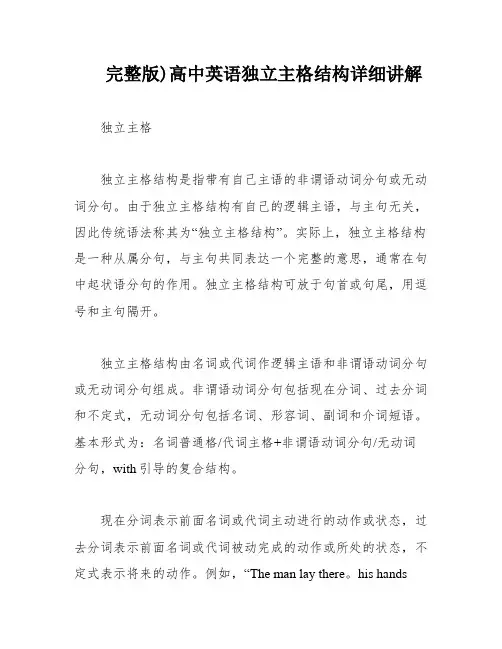
完整版)高中英语独立主格结构详细讲解独立主格独立主格结构是指带有自己主语的非谓语动词分句或无动词分句。
由于独立主格结构有自己的逻辑主语,与主句无关,因此传统语法称其为“独立主格结构”。
实际上,独立主格结构是一种从属分句,与主句共同表达一个完整的意思,通常在句中起状语分句的作用。
独立主格结构可放于句首或句尾,用逗号和主句隔开。
独立主格结构由名词或代词作逻辑主语和非谓语动词分句或无动词分句组成。
非谓语动词分句包括现在分词、过去分词和不定式,无动词分句包括名词、形容词、副词和介词短语。
基本形式为:名词普通格/代词主格+非谓语动词分句/无动词分句,with引导的复合结构。
现在分词表示前面名词或代词主动进行的动作或状态,过去分词表示前面名词或代词被动完成的动作或所处的状态,不定式表示将来的动作。
例如,“The man lay there。
his handstrembling.”,“So many students being ab sent。
the meeting had to be put off.”,“The boy lay on his back。
his hands crossed under his head.”,“He suggested going for a ic。
Mary to provide the food.”。
在独立主格结构中,being或havingbeen有时可以省略。
These are the first two books。
and the third one is set to be released next month。
We will gather at 7:30.and the n will XXX 8.Many people。
including women and children。
joined in the work。
He XXX。
The XXX。
so we had to wait outside for a while。
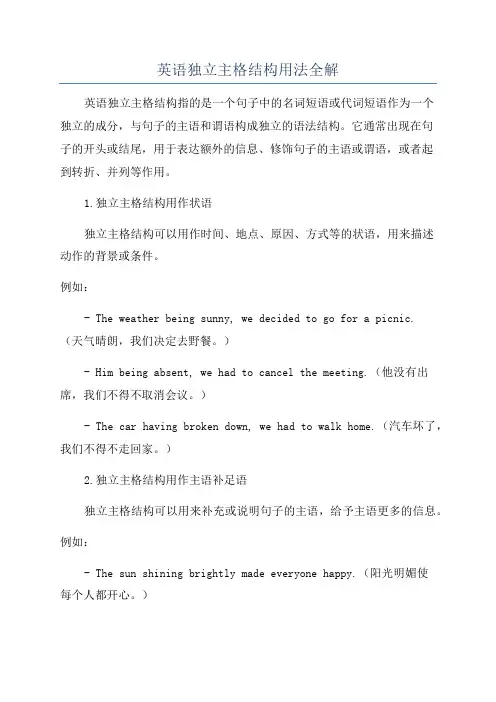
英语独立主格结构用法全解英语独立主格结构指的是一个句子中的名词短语或代词短语作为一个独立的成分,与句子的主语和谓语构成独立的语法结构。
它通常出现在句子的开头或结尾,用于表达额外的信息、修饰句子的主语或谓语,或者起到转折、并列等作用。
1.独立主格结构用作状语独立主格结构可以用作时间、地点、原因、方式等的状语,用来描述动作的背景或条件。
例如:- The weather being sunny, we decided to go for a picnic.(天气晴朗,我们决定去野餐。
)- Him being absent, we had to cancel the meeting.(他没有出席,我们不得不取消会议。
)- The car having broken down, we had to walk home.(汽车坏了,我们不得不走回家。
)2.独立主格结构用作主语补足语独立主格结构可以用来补充或说明句子的主语,给予主语更多的信息。
例如:- The sun shining brightly made everyone happy.(阳光明媚使每个人都开心。
)- Her parents' disapproval being obvious, she had no choice but to change her major.(她父母的不同意显而易见,她别无选择,只能换专业。
)- Your decision to quit the job in such a situation seems unwise.(在这种情况下,你决定辞职似乎不明智。
)3.独立主格结构用作动词补足语独立主格结构可以用来补充或说明句子的谓语动词,给予动词更多的意义和内容。
例如:- He stood there, hands in pockets, waiting for the bus.(他站在那儿,双手插在口袋里,等公交车。
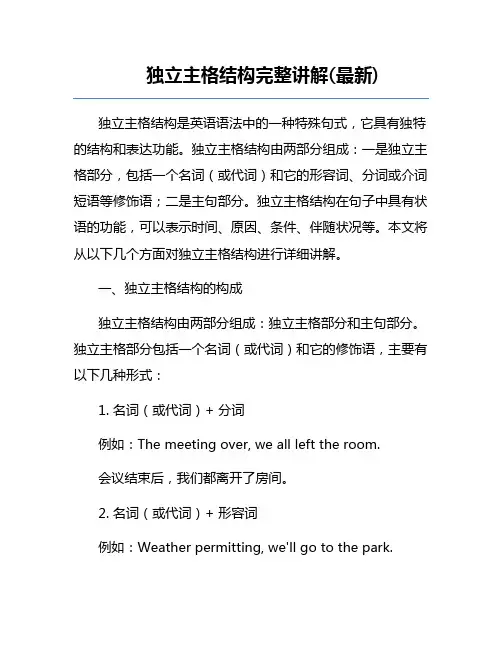
独立主格结构完整讲解(最新)独立主格结构是英语语法中的一种特殊句式,它具有独特的结构和表达功能。
独立主格结构由两部分组成:一是独立主格部分,包括一个名词(或代词)和它的形容词、分词或介词短语等修饰语;二是主句部分。
独立主格结构在句子中具有状语的功能,可以表示时间、原因、条件、伴随状况等。
本文将从以下几个方面对独立主格结构进行详细讲解。
一、独立主格结构的构成独立主格结构由两部分组成:独立主格部分和主句部分。
独立主格部分包括一个名词(或代词)和它的修饰语,主要有以下几种形式:1. 名词(或代词)+ 分词例如:The meeting over, we all left the room.会议结束后,我们都离开了房间。
2. 名词(或代词)+ 形容词例如:Weather permitting, we'll go to the park.如果天气允许,我们将去公园。
3. 名词(或代词)+ 介词短语例如:With the teacher's help, I improved my English.在老师的帮助下,我的英语取得了进步。
4. 名词(或代词)+ 副词例如:The students present, the teacher started the lecture.学生们都在场,老师开始了讲座。
二、独立主格结构的功能独立主格结构在句子中具有状语的功能,可以表示时间、原因、条件、伴随状况等。
以下是独立主格结构在不同情境下的应用:1. 表示时间例如:Spring coming, the trees begin to turn green.春天到来,树木开始变绿。
2. 表示原因例如:The game canceled, the fans were very disappointed.比赛取消,球迷们非常失望。
3. 表示条件例如:Weather permitting, we'll have a picnic this weekend.如果天气允许,这个周末我们将去野餐。
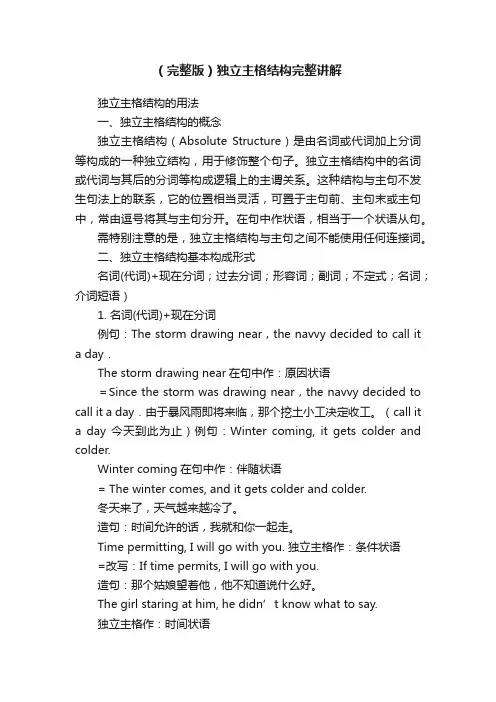
(完整版)独立主格结构完整讲解独立主格结构的用法一、独立主格结构的概念独立主格结构(Absolute Structure)是由名词或代词加上分词等构成的一种独立结构,用于修饰整个句子。
独立主格结构中的名词或代词与其后的分词等构成逻辑上的主谓关系。
这种结构与主句不发生句法上的联系,它的位置相当灵活,可置于主句前、主句末或主句中,常由逗号将其与主句分开。
在句中作状语,相当于一个状语从句。
需特别注意的是,独立主格结构与主句之间不能使用任何连接词。
二、独立主格结构基本构成形式名词(代词)+现在分词;过去分词;形容词;副词;不定式;名词;介词短语)1. 名词(代词)+现在分词例句:The storm drawing near,the navvy decided to call it a day.The storm drawing near在句中作:原因状语=Since the storm was drawing near,the navvy decided to call it a day.由于暴风雨即将来临,那个挖土小工决定收工。
(call it a day 今天到此为止)例句:Winter coming, it gets colder and colder.Winter coming在句中作:伴随状语= The winter comes, and it gets colder and colder.冬天来了,天气越来越冷了。
造句:时间允许的话,我就和你一起走。
Time permitting, I will go with you. 独立主格作:条件状语=改写:If time permits, I will go with you.造句:那个姑娘望着他,他不知道说什么好。
The girl staring at him, he didn’t know what to say.独立主格作:时间状语=改写:As the girl stared at him, he didn’t know what to say.2. 名词(代词)+过去分词例句:He was listening attentively in class, his eyes fixed on the blackboard.他上课专心听讲,眼睛紧盯着黑板。
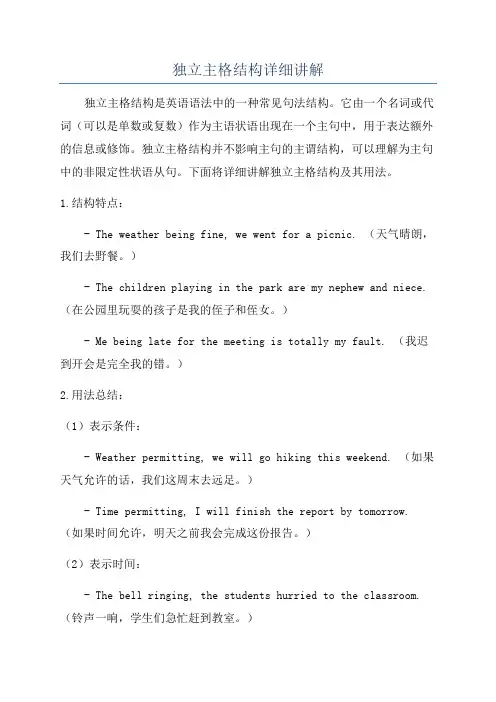
独立主格结构详细讲解独立主格结构是英语语法中的一种常见句法结构。
它由一个名词或代词(可以是单数或复数)作为主语状语出现在一个主句中,用于表达额外的信息或修饰。
独立主格结构并不影响主句的主谓结构,可以理解为主句中的非限定性状语从句。
下面将详细讲解独立主格结构及其用法。
1.结构特点:- The weather being fine, we went for a picnic. (天气晴朗,我们去野餐。
)- The children playing in the park are my nephew and niece. (在公园里玩耍的孩子是我的侄子和侄女。
)- Me being late for the meeting is totally my fault. (我迟到开会是完全我的错。
)2.用法总结:(1)表示条件:- Weather permitting, we will go hiking this weekend. (如果天气允许的话,我们这周末去远足。
)- Time permitting, I will finish the report by tomorrow. (如果时间允许,明天之前我会完成这份报告。
)(2)表示时间:- The bell ringing, the students hurried to the classroom. (铃声一响,学生们急忙赶到教室。
)- The sun having set, we decided to go home. (太阳已经下山了,我们决定回家。
)(3)修饰主句主语:- Tom, an experienced pilot, flew the airplane with confidence. (汤姆,一位有经验的飞行员,自信地驾驶着飞机。
)- Sally, a talented musician, played the piano at the concert. (莎莉,一位才华横溢的音乐家,在音乐会上弹奏钢琴。
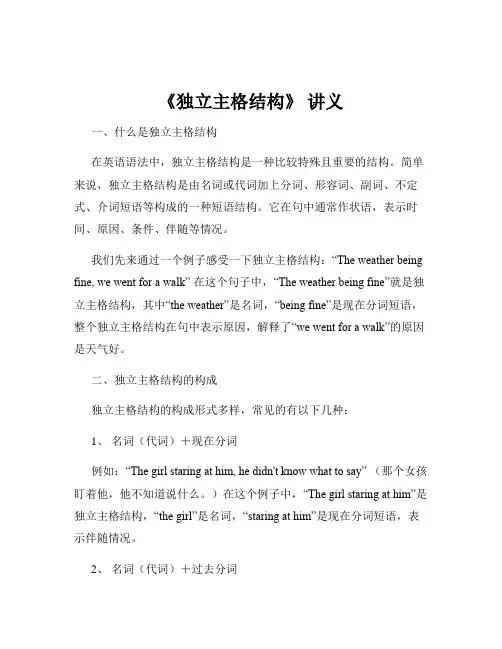
《独立主格结构》讲义一、什么是独立主格结构在英语语法中,独立主格结构是一种比较特殊且重要的结构。
简单来说,独立主格结构是由名词或代词加上分词、形容词、副词、不定式、介词短语等构成的一种短语结构。
它在句中通常作状语,表示时间、原因、条件、伴随等情况。
我们先来通过一个例子感受一下独立主格结构:“The weather being fine, we went for a walk” 在这个句子中,“The weather being fine”就是独立主格结构,其中“the weather”是名词,“being fine”是现在分词短语,整个独立主格结构在句中表示原因,解释了“we went for a walk”的原因是天气好。
二、独立主格结构的构成独立主格结构的构成形式多样,常见的有以下几种:1、名词(代词)+现在分词例如:“The girl staring at him, he didn't know what to say” (那个女孩盯着他,他不知道说什么。
)在这个例子中,“The girl staring at him”是独立主格结构,“the girl”是名词,“staring at him”是现在分词短语,表示伴随情况。
2、名词(代词)+过去分词比如:“The task completed, they had a rest” (任务完成了,他们休息了一下。
)这里,“The task completed”是独立主格结构,“the task”是名词,“completed”是过去分词,表示时间。
3、名词(代词)+形容词“Her face pale with anger, she stormed out of the room” (她气得脸色苍白,冲出了房间。
)“Her face pale with anger”为独立主格结构,“her face”是名词,“pale with anger”是形容词短语,描述状态。
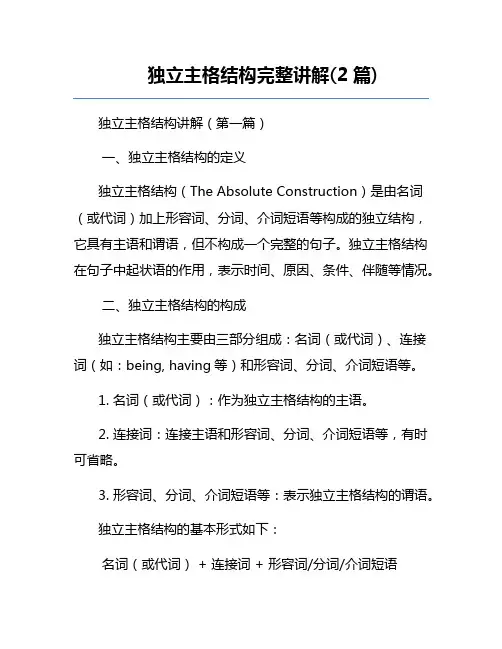
独立主格结构完整讲解(2篇) 独立主格结构讲解(第一篇)一、独立主格结构的定义独立主格结构(The Absolute Construction)是由名词(或代词)加上形容词、分词、介词短语等构成的独立结构,它具有主语和谓语,但不构成一个完整的句子。
独立主格结构在句子中起状语的作用,表示时间、原因、条件、伴随等情况。
二、独立主格结构的构成独立主格结构主要由三部分组成:名词(或代词)、连接词(如:being, having等)和形容词、分词、介词短语等。
1. 名词(或代词):作为独立主格结构的主语。
2. 连接词:连接主语和形容词、分词、介词短语等,有时可省略。
3. 形容词、分词、介词短语等:表示独立主格结构的谓语。
独立主格结构的基本形式如下:名词(或代词) + 连接词 + 形容词/分词/介词短语三、独立主格结构的用法1. 表示时间独立主格结构可以表示时间,相当于时间状语从句。
例句:The meeting over, everyone left the room.会议结束后,大家都离开了房间。
2. 表示原因独立主格结构可以表示原因,相当于原因状语从句。
例句:The rain having stopped, they continued their journey.雨停了,他们继续赶路。
3. 表示条件独立主格结构可以表示条件,相当于条件状语从句。
例句:No one opposing, the plan was adopted.没有人反对,计划得以通过。
4. 表示伴随独立主格结构可以表示伴随情况,相当于伴随状语从句。
例句:His hands in his pockets, he strolled along the street.他双手插在口袋里,沿街漫步。
四、注意事项1. 独立主格结构中的名词(或代词)与主句的主语不能是同一主语。
2. 独立主格结构中的谓语动词必须是分词形式,不能是动词原形。
3. 独立主格结构在句中的作用相当于状语,表示时间、原因、条件、伴随等情况。

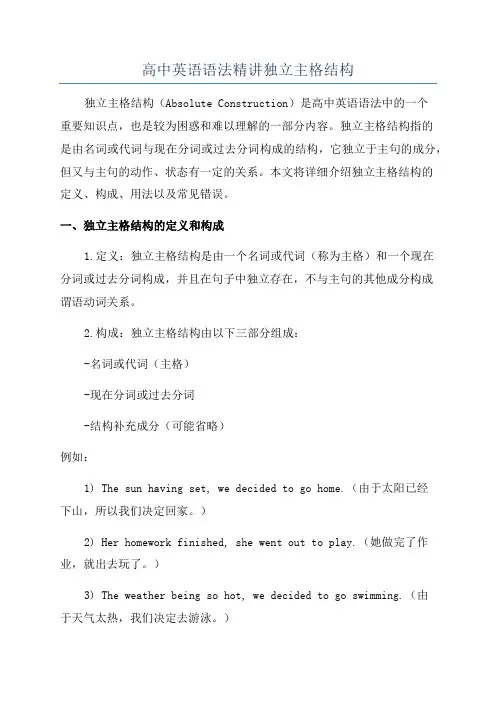
高中英语语法精讲独立主格结构独立主格结构(Absolute Construction)是高中英语语法中的一个重要知识点,也是较为困惑和难以理解的一部分内容。
独立主格结构指的是由名词或代词与现在分词或过去分词构成的结构,它独立于主句的成分,但又与主句的动作、状态有一定的关系。
本文将详细介绍独立主格结构的定义、构成、用法以及常见错误。
一、独立主格结构的定义和构成1.定义:独立主格结构是由一个名词或代词(称为主格)和一个现在分词或过去分词构成,并且在句子中独立存在,不与主句的其他成分构成谓语动词关系。
2.构成:独立主格结构由以下三部分组成:-名词或代词(主格)-现在分词或过去分词-结构补充成分(可能省略)例如:1) The sun having set, we decided to go home.(由于太阳已经下山,所以我们决定回家。
)2) Her homework finished, she went out to play.(她做完了作业,就出去玩了。
)3) The weather being so hot, we decided to go swimming.(由于天气太热,我们决定去游泳。
)二、独立主格结构的用法独立主格结构常用于下面几种情况:1.表示主句和从句发生的动作同时进行例如:- The teacher leaving the room, the students began to talk.(老师离开教室,学生们就开始聊天。
)2.表示原因、条件或时间例如:- The story being interesting, I couldn't help but read it all night.(由于这个故事很有趣,所以我忍不住整夜读完了它。
)3.表示伴随、结果或程度例如:- His hands trembling, he couldn't hold the cup steady.(他的手颤抖着,无法将杯子稳住。
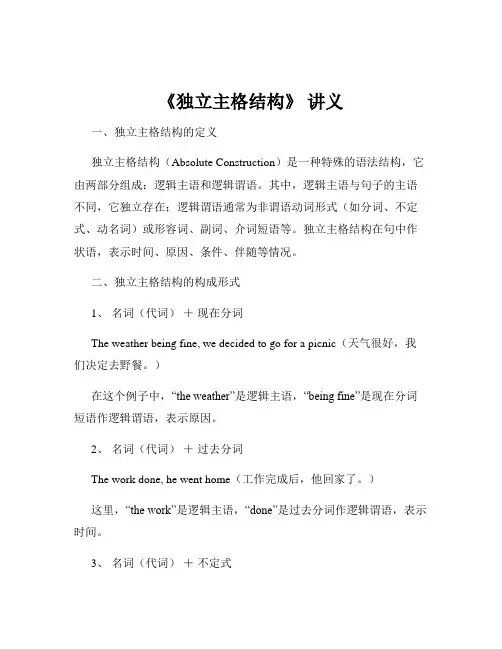
《独立主格结构》讲义一、独立主格结构的定义独立主格结构(Absolute Construction)是一种特殊的语法结构,它由两部分组成:逻辑主语和逻辑谓语。
其中,逻辑主语与句子的主语不同,它独立存在;逻辑谓语通常为非谓语动词形式(如分词、不定式、动名词)或形容词、副词、介词短语等。
独立主格结构在句中作状语,表示时间、原因、条件、伴随等情况。
二、独立主格结构的构成形式1、名词(代词)+现在分词The weather being fine, we decided to go for a picnic(天气很好,我们决定去野餐。
)在这个例子中,“the weather”是逻辑主语,“being fine”是现在分词短语作逻辑谓语,表示原因。
2、名词(代词)+过去分词The work done, he went home(工作完成后,他回家了。
)这里,“the work”是逻辑主语,“done”是过去分词作逻辑谓语,表示时间。
3、名词(代词)+不定式A lot of work to do, I have to stay up late(有很多工作要做,我不得不熬夜。
)“a lot of work”是逻辑主语,“to do”是不定式作逻辑谓语,表示原因。
4、名词(代词)+形容词He came into the room, his face red with anger(他走进房间,脸气得通红。
)“his face”是逻辑主语,“red with anger”是形容词短语作逻辑谓语,表示伴随。
5、名词(代词)+副词The meeting over, they went home(会议结束了,他们回家了。
)“the meeting”是逻辑主语,“over”是副词作逻辑谓语,表示时间。
6、名词(代词)+介词短语The teacher came in, a book in his hand(老师进来了,手里拿着一本书。
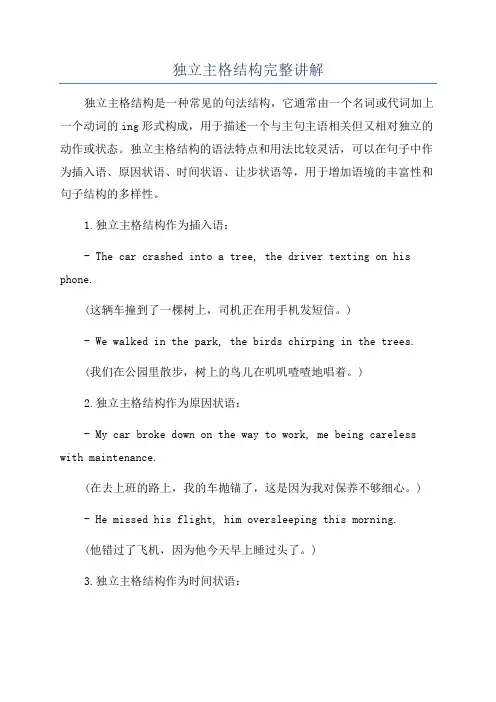
独立主格结构完整讲解独立主格结构是一种常见的句法结构,它通常由一个名词或代词加上一个动词的ing形式构成,用于描述一个与主句主语相关但又相对独立的动作或状态。
独立主格结构的语法特点和用法比较灵活,可以在句子中作为插入语、原因状语、时间状语、让步状语等,用于增加语境的丰富性和句子结构的多样性。
1.独立主格结构作为插入语:- The car crashed into a tree, the driver texting on his phone.(这辆车撞到了一棵树上,司机正在用手机发短信。
)- We walked in the park, the birds chirping in the trees.(我们在公园里散步,树上的鸟儿在叽叽喳喳地唱着。
)2.独立主格结构作为原因状语:- My car broke down on the way to work, me being careless with maintenance.(在去上班的路上,我的车抛锚了,这是因为我对保养不够细心。
) - He missed his flight, him oversleeping this morning.(他错过了飞机,因为他今天早上睡过头了。
)3.独立主格结构作为时间状语:- I spent the whole day in the library, my friends hanging out at the beach.(我整天都呆在图书馆,好朋友们都在海滩玩。
)(她连续加班数周,她的同事休产假了。
)4.独立主格结构作为让步状语:- Despite the rain, the kids played outside, their parents not minding the wet clothes.(尽管下着雨,孩子们还是在外面玩,他们的父母并不介意弄湿衣服。
)- For all his efforts, he still failed the exam, him not studying hard enough.(尽管付出了努力,他还是考试不及格,因为没有学习足够努力。
独立主格结构完整讲解独立主格作:方式状语While he was XXX in class。
his eyes were fixed on the blackboard.例句:The job finished。
he felt a sense of relief.工作完成后,他感到一种解脱感。
独立主格作:原因状语After the job was finished。
he felt a sense of relief.造句:她看到他走进房间,心情变得很好。
Seeing him walk into the room。
she felt much better.独立主格作:原因状语Because she saw him walk into the room。
she felt much better.三、常见的独立主格结构1.时间状语:time permitting,when he was young,afterthe war,before long,at present,nowadays,in the past,in the future等。
2.原因状语:the job finished,the book read,the work done,the n made,the problem solved等。
3.条件状语:weather permitting,time allowing,XXX等。
4.方式状语:eyes fixed,hands folded,mouth open,head down等。
5.伴随状语:the sun shining,the XXX,XXX falling等。
6.比较状语:the same being true of,the XXX等。
7.让步状语:his leg being broken,XXX bad等。
独立主格结构是一种灵活的修饰方式,可以在句子中起到多种不同的作用。
需要注意的是,独立主格结构与主句之间不能使用任何连接词,这是其与其他句子成分的主要区别。
独立主格结构的全面讲解独立主格:非谓语动词带有自己的逻辑主语,在句中作状语,被称为独立主格结构1,逻辑主语+现在分词Time permitting,we will discuss more questions. 如果时间允许的话,我们将讨论更多的问题。
2,逻辑主语+过去分词The bag lost ,he had no money now. 由于书包丢了,他现在没有钱了。
3,逻辑主语+不定式Lots of homework to do ,I must do it now. 由于很多家庭作业要做,我现在必须做到。
4,其他形式的独立主格结构:1,逻辑主语+名词Many children are reading here ,most of them Chinese. 许多还在这里读书,大多数都是中国人。
2,逻辑主语+形容词:He reads books here ,his hands big and fat. 他在这里读书,他的手大而且胖。
3,逻辑主语+副词He pulled on his coat ,wrong side out. 他穿上他的外套,结果穿反了。
4,逻辑主语+介词短语He sat there ,his eyes on her back. 他坐在那里,眼睛望着她的背影。
With,without+复合宾语的结构1,With the coat wet,you can't wear it.由于外套是湿的,你不能穿它。
2,Without his mother out ,you can't come here. 由于他的母亲在家,你不能来这里。
3,The wall will be more beautiful with many pictures on it. 有了许多图片,这个墙更加的美丽。
4,With the teacher to teach ,you will find the best method. 由于这个老师的教育,你将会找到最好的方法。
独立主格结构独立主格结构(Absolute Structure)是由名词或代词加上分词等构成的一种独立结构,用于修饰整个句子。
独立主格结构中的名词或代词与其后的分词等构成逻辑上的主谓关系。
这种结构与主句不发生句法上的联系,它的位置相当灵活,可置于主句前、主句末或主句中,常由逗号将其与主句分开。
需特别注意的是,独立主格结构与主句之间不能使用任何连接词。
二、独立主格结构基本构成形式名词(代词)+现在分词(过去分词;形容词;副词;不定式;名词;介词短语)1. 名词(代词)+现在分词Night enshrouding the earth, nobody could make out what the dark mass was from a distance.黑夜笼罩大地,谁也看不清远处黑压压的一片是什么东西。
There being no bus, we had to walk home.由于没有公共汽车,我们只好走回家。
2. 名词(代词)+过去分词The workers worked still harder, their living conditions greatly improved.由于工人们的生活条件大大提高,他们工作得更起劲了。
He was listening attentively in class, his eyes fixed on the blackboard.他上课专心听讲,眼睛紧盯着黑板。
3. 名词(代词)+不定式在“名词/代词+动词不定式”结构中,动词不定式和它前面的名词或代词如果存在着逻辑上的主谓关系,动词不定式则用主动的形式;如果是动宾关系,则用被动形式。
The four of us agreed on a division of labor, each to translate a quarter of the book.我们四人同意分工干,每人翻译全书的四分之一。
Many trees, flowers, and grass to be planted, our newly-built school will look even more beautiful.种上许多的树、花和草后,我们新建的学校看上去将更美。
独立主格8种结构一、独立主格结构是指在句子中,独立地出现的名词性短语,它不与主句的其他成分构成任何关系,一般用逗号隔开。
1. 时间状语独立主格结构例如:走到窗前,小明看到了美丽的夕阳。
在这个例句中,“走到窗前”是时间状语独立主格结构,它表示的是动作的时间。
2. 原因状语独立主格结构例如:天气太热了,大家都不愿意出去玩。
在这个例句中,“天气太热了”是原因状语独立主格结构,它表示的是动作的原因。
3. 条件状语独立主格结构例如:天气好的话,我们就去游泳吧。
在这个例句中,“天气好的话”是条件状语独立主格结构,它表示的是动作的条件。
4. 目的状语独立主格结构例如:为了赚钱,他每天都加班到很晚。
在这个例句中,“为了赚钱”是目的状语独立主格结构,它表示的是动作的目的。
5. 结果状语独立主格结构例如:他学习非常努力,成绩自然会提高。
在这个例句中,“他学习非常努力”是结果状语独立主格结构,它表示的是动作的结果。
6. 让步状语独立主格结构例如:尽管天气很冷,他还是坚持锻炼。
在这个例句中,“尽管天气很冷”是让步状语独立主格结构,它表示的是动作的让步条件。
7. 方式状语独立主格结构例如:他边听音乐,边做作业。
在这个例句中,“边听音乐”是方式状语独立主格结构,它表示的是动作的方式。
8. 伴随状语独立主格结构例如:他一边吃饭,一边看电视。
在这个例句中,“一边吃饭”是伴随状语独立主格结构,它表示的是动作的伴随状态。
通过以上的例子,我们可以看出独立主格结构的灵活运用能够使得句子更加丰富多样,表达更加准确清晰。
熟练掌握这些结构,能够让我们的写作更加生动有趣,同时也能提高我们的语言表达能力。
所以,在写作中,我们应该多加运用独立主格结构,让我们的句子更加地道、准确。
独立主格结构:独立主格结构,又叫独立结构(absolute construction).它在句法上游离与句子主体之外,跟主句没有任何语法联系;但在意义上却与主句紧密联系在一起,给他构成一个完整的寓意环境。
独立主格结构没有主语和位于,只有逻辑上的主语,因此,它在句法上不是句子,而是一个独立于句子成分之外的独特结构形式。
独立主格结构可置于句首、句尾,用逗号上与主句隔开。
一、独立主格结构的形式独立结构可分为俩部分,一部分事名词或代词(主格),起着逻辑主语的作用;另一部分由形容词、副词、名词、分词、不定式、介词短语等构成,表示前面名词或代词的状态或动作。
1)名词/代词+形容词I heard that she got injured in the accident , my heart full of worry. 我听说她在这次事故中受了伤,内心充满担忧。
He stood silent in the moon-light, his door open .月光下,门开着,他默默地站在那。
2)名词/代词+现在分词Winter coming ,it gets colder and colder. 冬天来了,天气越来越冷了。
The rain having stopped ,he went out for a walk. 雨停了,他出去散散步。
3)名词/代词+过去分词More time given ,we should have done it much better. 如果给我们更多时间,我们会做的更好。
The boy stood there , his right hand raised. 那个男生站在那里,右手高举。
4)名词/代词(主格)+不定式Here are the first two volumes , the third one to come out next month.这是前俩卷,第三卷将于下雨问世。
独立主格结构详细讲解独立主格一、独立主格结构的含义和实质独立主格结构”(absolute n)是一种带有自己主语的非谓语动词分句或无动词分句。
由于在语法上有自己的逻辑主语,结构上与主句不发生关系,因此传统语法称之为“独立主格结构”。
实际上,它是一种从属分句,与主句紧密联系在一起,通常在句中起状语分句的作用。
独立主格结构可放于句首、句尾,用逗号和主句隔开。
二、独立主格结构的基本形式和功能独立主格结构由名词或代词和非谓语动词分句(现在分词、过去分词、不定式)或无动词分句(名词、形容词、副词、介词短语)组成,表示前面名词或代词的动作或状态。
基本形式为:名词普通格/代词主格+现在分词/过去分词/不定式/名词/形容词/副词/介词短语,with引导的复合结构。
1.名词/代词+现在分词现在分词表示前面的名词或代词主动进行的动作或状态等。
例如:The man lay there。
his hands trembling。
So many students being absent。
the meeting had to be put off。
His homework done。
Tom went to sleep.注:“独立结构”中的being或havingbeen有时可以省去,这样就成了无动词分句或过去分词分句。
2.名词/代词+过去分词过去分词表示前面的名词或代词被动完成的动作或所处的一种状态。
例如:The boy lay on his back。
his hands crossed under his head。
The job not finished。
we couldn’t see the film。
Her shirt caught on a nail。
she could not move.后面两个句子也可以看成省略掉了havingbeen,being。
如果加上,这两个句子就又变成了现在分词分句。
3.名词/代词+不定式不定式表示将来的动作。
一、独立主格结构的概念独立主格结构(Absolute Structure )是由名词或代词加上分词等构成的一种独立结构,用于修饰整个句子。
独立主格结构中的名词或代词与其后的分词等构成逻辑上的主谓关系。
这种结构与主句不发生句法上的联系,它的位置相当灵活,可置于主句前、主句末或主句中,常由逗号将其与主句分开。
在句中作状语,相当于一个状语从句。
需特别注意的是,独二、独立主格结构基本构成形式名词(代词)+现在分词;过去分词;形容词;副词;不定式;名词;介词短语)1. 名词(代词)+现在分词例句:The storm drawing near ,the navvy decided to call it a dayThe storm drawi ng n ear 在句中作:原因状语=Si nee the storm was draw ing n ear , the n avvy decided to call it a day由于暴风雨即将来临,那个挖土小工决定收工。
(call it a day 今天到此为止)例句:Win ter comin g, it gets colder and colder.Win ter comi ng 在句中作:伴随状语=The win ter comes, and it gets colder and colder.冬天来了,天气越来越冷了。
造句:时间允许的话,我就和你一起走。
Time permitti ng, I will go with you. 独立主格作:条件状语=改写:f time permits, I will go with you. ___________造句:那个姑娘望着他,他不知道说什么好。
The girl staring at him, he didn ' t know what to say.独立主格作:时间状语=改写:As the girl stared at him, he didn ' t know what to say.2.名词(代词)+过去分词例句:He was listening attentively in class, his eyes fixed on theblackboard.他上课专心听讲,眼睛紧盯着黑板。
例句:The meeti ng gone over, every one tired to go homeearlier. 会议结束后,每个人都想早点回家。
造句:工作完成后,他回家了。
The work done, he went back home.=Whe n the work was done, he went back home.3. 名词(代词)+不定式在“名词/代词+动词不定式”结构中,动词不定式和它前面的名词或代词如果存在着逻辑上的主谓关系,动词不定式则用主动的形式;如果是动宾关系,则用被动形式。
例句:The four of us agreed on a division of labor, each to translate a quarterof the book.我们四人同意分工干,每人翻译全书的四分之一。
例句:Many trees, flowers, and grass to be planted, our school will look even more beautiful.种上许多的树、花和草后,我们新建的学校看上去将更美。
造句:还有很多作业要做,我不能和你走。
A lot of home work to do, I can ' t go with you.4. 名词(代词)+形容词Computers very small, we can use them widely.电脑虽小,我们却能广泛地利用它们。
he stood sile nt in the noon sun light, its door ope n.5. 名词(代词)+副词The meeti ng over, our headmaster soon left the meeti ng room.散会了,校长很快就离开了会议室。
灯熄了,我们不能继续工作了。
造句:The lights off, we could not go on with the work.6. 名词(代词)+名词His first shot failure ,he fired again他第一枪没击中,又打了一枪。
Two hun dred people died in the accide nt, many of them childre n.两百人死于事故,其中有许多儿童。
7. 名词(代词)+介词短语The hun tsma n en tered the forest, gun in hand.那位猎人手里提着枪走进了树林。
三、with ,without 引导的独立主格结构with ( without)+ 宾语(名词/代词)+宾语补足语,宾语通常由名词或代词充当, 但代词一定要用宾格。
上文的独立主格结构的几种情况都适用于此结构。
The girl hid her box without anyone knowing where it was.小女孩把盒子藏了起来,没有人知道它在哪里。
(without + 名词/代词+动词的-ing 形式)Without a word more spoke n, she left the meeti ng room.她没再说什么话就离开了会议室。
(without+ 名词/代词+动词的-ed 形式)The kid feels excited with so many places of interest to visit.有这么多的名胜可参观,小孩很激动。
(with+名词/代词+动词不定式)The boy was walk ing, with his father ahead.父亲在前,小孩在后走着。
(with+名词/代词+副词)He stood at the door, with a computer in his hand.或He stood at the door, computer in hand.他站在门口,手里拿着一部电脑。
(with+名词/代词+介词短语)With his son so disappo inting, the old man felt un happy.由于儿子如此令人失望,老人感到很不快乐。
(with+名词/代词+形容词)在with (without)的复合结构中,多数情况下with 能省略,但without 不能省略。
造句:老师走进教室,胳膊下面夹了一本书。
The teacher walked into the classroom, with a book un der his arm.造句:老师坐在椅子上,周围一群学生围着他。
The teacher is sitti ng in the chair, with a group of stude nts around him造句:工作完成了,他回家了。
With the work done, he went back home.造句:由那个男孩带路,我们很容易就找到了那奇怪的洞。
With the boy leading the way, we had no trouble finding the strange cave.四、独立主格结构的句法功能独立主格结构在句中一般作状语,表示时间、条件、原因、伴随状况等,还可以作定语。
1. 作时间状语My shoes removed ,I entered a low-ceilinged room ,treading cautiously on the soft tatami matt ing我脱掉鞋子后,走进一间屋顶很低的房间,小心翼翼地踩在柔软的塌塌米垫子上。
The governor pondering the matter ,more strikers gathered across his path .总督思考问题时,更多的罢工工人聚集在他要通过的路上。
2. 作条件状语Weather permitting , they will go on an outing to the beach tomorrow .如果天气允许的话,他们将在明天组织一次海滨郊游。
Such being the case , you have no grounds for dismissing him 如果情况如此的话,你没有理由解聘他。
3. 作原因状语The boy lead ing the way, we had no trouble finding the stra ngecave.由那个男孩带路,我们很容易就找到了那奇怪的洞。
There being no further bus in ess to discuss, we all went home.没有别的事可讨论,我们都回家了。
4. 作伴随状语或补充说明I took my ticket ,and marched proudly up the platform ,with mycheeses ,the people falling back respectfully on either side .我拿着车票还有我的奶酪,雄赳赳气昂昂地跨步走向月台。
人们似乎很尊敬我,纷纷向两边退去。
Ten students entered for the competition, the youngest a boyof 12.十个学生报名参加了这次竞赛,年纪最小的是个12 岁的男孩。
五、独立主格结构的特殊用法1、有些分词短语可以独立存在, 在句子中没有逻辑上的主语, 实际上已经变成了习惯用法。
这些短语有:Generally speaking 总的说来, Frankly speaking 坦率地说,Judging from 从....... 判断,Supposing 假设,等等。
①Generally speaking, the rule is very easy to understand.总的说来, 这条规则很容易懂。
②Judgi ng from what he said, he must be an hon est man.由他所说的来判断, 他一定是一个诚实的人。
2、有些固定短语是带to 的不定式, 表明说话人的立场或态度, 在句中作独立成分。
这些短语有:to be honest 老实说,to be sure 确实,to tell you the truth 说实话,to cuta long story short 长话短说,to be frank 坦率地说,to make matters / things worse 更糟糕的是, 等等。